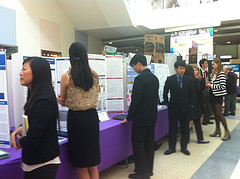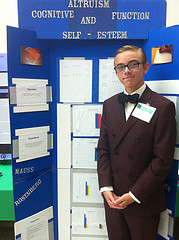Listen to a story by Annenberg Radio News
The California Science Center hosted the 42nd Annual State Fair today, where students proved just how talented their generation of young scientists really is.
American writer Pearl Buck once said: “The young do not know enough to be prudent. They attempt the impossible, and achieve it, generation after generation.”
Today, more than 1,000 students tried to explain the impossible through science at the 42nd Annual State Science Fair in Exposition Park.
These students ranged from 6th to 12th grade and traveled from all over the state to be there. Their projects were truly original. They had tested everything from reducing bacteria in lakes to the effects of petroleum on society.
“These kids are just so amazing. Every year it drives you crazy how really good they are and how inspiring,” said Allen Frew, Chairman of the California State Science Fair for the past six years.
Rows and rows of excited students stood beside their projects with pride. Their projects fit into the museum’s actual exhibits seamlessly. As I walked amongst them, they would stand up straighter and smile politely – I think they thought I was a judge.
Talie Cloud, an energetic seventh grade girl, was eager to tell me about her project.
“I tested the effects of various coffee bean roasts to the heart rate and longevity of daphnia magna which is an aquatic organism commonly known as the water flea,” Cloud said confidently.
Yeah so she lost me. But that’s just a glimpse into how smart these kids are. In layman’s terms, Cloud tested the effects of coffee to see if a specific blend can increase the length of your life.
“So what I concluded is that the light roasted coffee was beneficial for longevity and I believe with more studies by scientists this could potentially help humans,” Cloud said with a smile.
Last month, Congress completed its work on the 2013 spending bill that laid out the budgets for science organizations such as the National Science Foundation and NASA. But other research agencies like the National Institute of Health continues to feel the effects of a 5.1% spending cut.
“What happens is that these kids don’t get a chance to do hands on science. It’s damaging to the country overall,” Frew said.
The STEM initiative, which stands for science, technology, engineering and math – works to encourage education and funding in these fields through legislative action.
“This whole STEM initiative is very important to the country because that’s where you get the innovation and creativity and you drive the things that we see every day,” Frew explained.
And it’s at fairs like this that kids are questioning and exploring topics that do indeed drive the things that we see every day.
The bottom line is that science affects much more than we may realize.
“It’s really an across the board issue, it’s not just our military isn’t going to be as great. It’s also the consumer products. It’s also the every day things that you do. It’s your cars, other things like that,” Frew said.
When Talie cloud grows up, she wants to be a surgeon. Randy Kmet is a 9th grade boy who tested the effects of altruism on your self-esteem; he wants to go into another sector that desperately needs a science advocate.
“I feel I’m more suited for politics, I can fund the sciences there,” Kmet said.
Science funding continues to be a hot topic in the political world and hopefully Kmet makes it to Washington one day. Maybe Congress should’ve taken a field trip to the fair to gain some perspective into exactly what is on the chopping block.


















Speak Your Mind